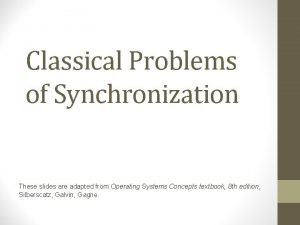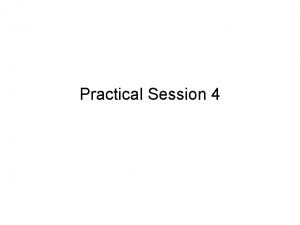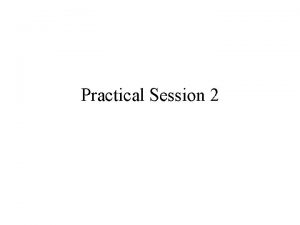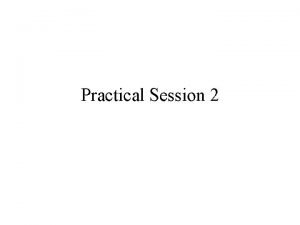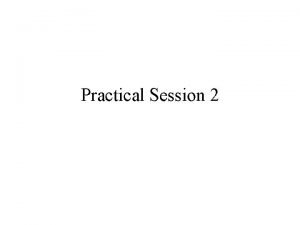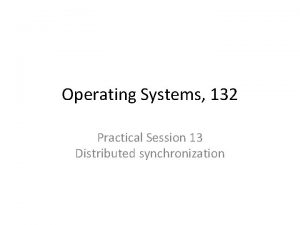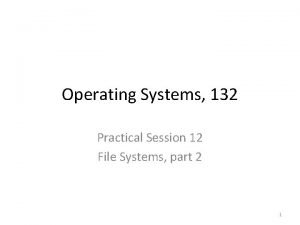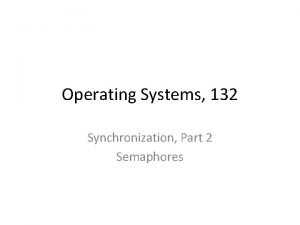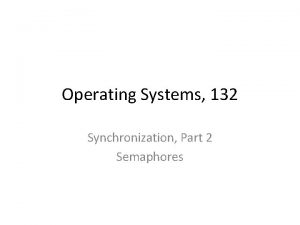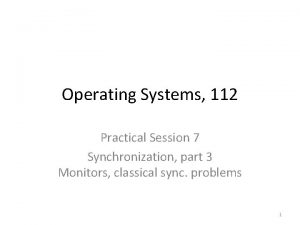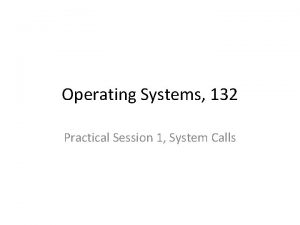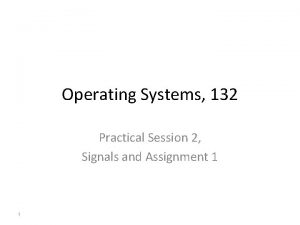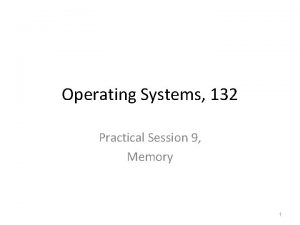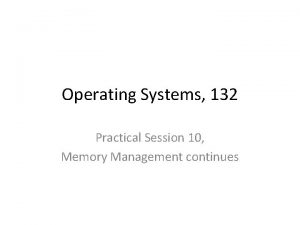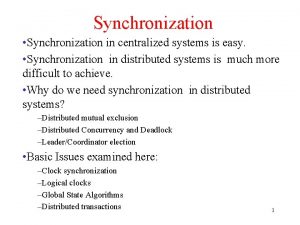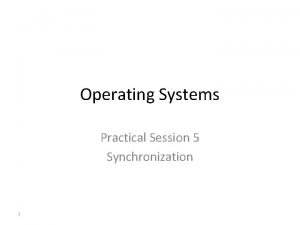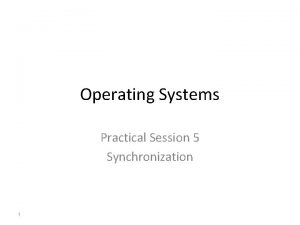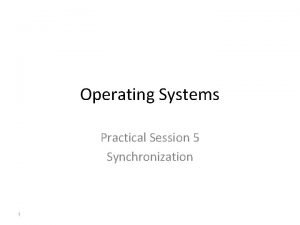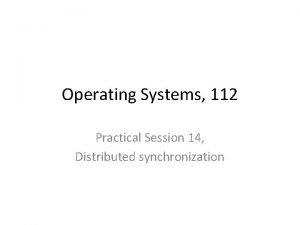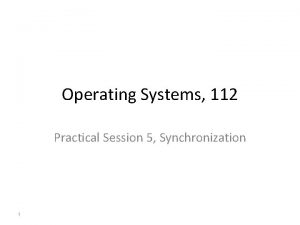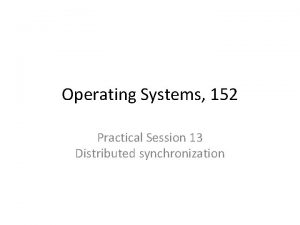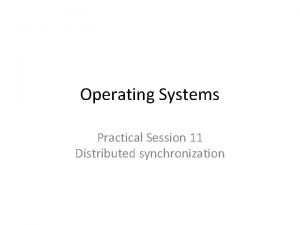Operating Systems 132 Practical Session 7 Synchronization part















![The one way tunnel (exam 2004) The one way tunnel solution: int Semaphore count[2]; The one way tunnel (exam 2004) The one way tunnel solution: int Semaphore count[2];](https://slidetodoc.com/presentation_image/c88d0a7721f08e36ee83b7648a500bbe/image-16.jpg)






![One way, convoy (midterm 2008) Prepare. To. Cross(int i){ down(&waiting. To. Cross[i]); down(&mutex); waiting. One way, convoy (midterm 2008) Prepare. To. Cross(int i){ down(&waiting. To. Cross[i]); down(&mutex); waiting.](https://slidetodoc.com/presentation_image/c88d0a7721f08e36ee83b7648a500bbe/image-23.jpg)






- Slides: 29

Operating Systems, 132 Practical Session 7 Synchronization, part 3 Monitors, classical sync. problems 1

Monitor • Monitor – a synchronization primitive. • A monitor is a collection of procedures, variables and data structures, grouped together. • Mutual Exclusion – only one process can be active within a monitor at any given time. • Programming language construct! The compiler of the language will know that monitors procedures are different than other procedures, and will treat them differently. That means that the compiler is in charge of the mutual exclusion implementation. Java synchronized methods 2

A quick recap Condition variables • A way for processes to block when they can’t continue. • Despite its name, it is used to indicate an event and not as a regular valued variable. A CV is not a counter! • Two operations: wait, signal. Wait: causes the process to block, and allows entry of other Wait threads to the monitor. Signal: Signal More than just one alternative: 1. 2. Hoare type monitors: The signaler yields the monitor to the Hoare released thread. Signal will be the last operation within the monitor, which wakes up waiting processes (waiting on the same variable). This is not true for Java Mesa type monitors: The signaling process is allowed to continue. Mesa 3

The Sleeping Barber Write a solution to the sleeping barber problem using monitors and condition variables. Reminder, the sleeping barber: 1. 2. 3. 4. The barber cuts peoples hair in his shop, which has 2 doors – entrance and exit. When people are in his shop, he gives them a hair cut, one at a time. When none are in his shop, he sleeps on his chair. When a customer arrives and finds the barber sleeping, he awakens him and sits in the barber’s chair to receive his haircut. After the cut is done, the barber sees the customer out through the exit door. If the barber is busy when a customer arrives, the customer waits in one of the chairs in the shop. If all are occupied, he goes away. After serving a customer the barber looks to see if any are waiting and if so proceeds to serve one of them. Otherwise, he sleeps again in his chair. 4

The Sleeping Barber barbershop: monitor waiting : integer : = 0; % customers waiting for haircut customers : condition; % used by barber, wait for a customer barber : condition; % used by customer, wait for barber procedure seek-customer( ) % called by the barber begin if waiting==0 then WAIT (customers); % sleeps if no customers cut-hair(); waiting = waiting-1; % one less customer waiting SIGNAL (barber); % free a waiting customer end seek-customer; 5

The Sleeping Barber procedure get-haircut( ) % called by a customer begin % is there a free chair to sit and wait? % if no free chairs just go away if waiting < chairs then { waiting = waiting+1; SIGNAL (customers) WAIT (barber); } end get-haircut; end barbershop; % one more customer waiting % if the barber is asleep % wait for turn with the barber % End of monitor 6

Java and monitors – Exercise Write a code snippet in Java which will enforce a FIFO waking order (i. e. , create a class in Java that will allow a programmer fair synchronization) 7

Java and monitors – Solution class Wait. Object { boolean released = false; } // this flag avoids race!!! synchronized void do. Wait() { while (! released) { try { wait(); } catch (Interrupted. Exception ie) {} // ignore it } } synchronized void do. Notify(){ if (! released){ released = true; notify(); } } 8

Java and monitors – Solution class Critical. Section { private Vector _waiting; private boolean _busy; // critical section that preserves FIFO // wait list // someone in critical section public Critical. Section() { // constructor _waiting = new Vector(); // create wait list _busy = false; // no one is in the CS now. } public void enter() { Wait. Object my_lock = null; synchronized(this){ if (! _busy) { _busy = true; return; }else { my_lock = new Wait. Object(); // create my unique lock _waiting. add(my_lock); // add to waiting list } } my_lock. do. Wait(); // wait on lock } 9

Java and monitors – Solution public synchronized void leave() { if (_waiting. size() > 0) { // someone is waiting Wait. Object o = (Wait. Object)_waiting. element. At(0); _waiting. remove. Element. At(0); o. do. Notify(); } else { _busy = false; } } } 10

Java and monitors – Discussion Does this code guarantee a FIFO waking order which is equivalent to the order in which threads reached the critical section entrance? NO! public void enter() { Wait. Object my_lock = null; synchronized(this){ … } my_lock. do. Wait(); } What happens when multiple threads attempt to enter at the same time? It does, however, guarantee a waking order on those threads already sleeping. 11

Hoare monitors, Moed A 2010 Monitor Producer. Consumer 1. condition full, empty 2. integer count initially 0 3. procedure insert(item: integer) 4. begin 5. if count=N then wait(full) wait 6. insert_item(item) 7. count=count+1 8. if count > 0 then signal(empty) signal 9. end 10. procedure remove: integer 11. begin 12. if count=0 then wait(empty) wait 13. remove=remove_item() 14. count=count-1 15. if count < N then signal(full) signal 16. end Monitor 12

Hoare monitors, Moed A 2010 Recall that a monitor is a Hoare typed monitor if the following conditions hold: 1. Whenever a ‘signal’ is received by a thread t it is guaranteed that thread t will be the next thread to enter the monitor 2. ‘signal’ is the last action taken within the monitor and a thread executing it will immediately release the monitor afterward Consider the above implementation for the producer consumer problem with N items and prove or disprove the following claim: The above implementation is correct even if used with non Hoare typed monitor 13

Hoare monitors, Moed A 2010 The following scenario contradicts the above claim: Assume an N sized buffer, already full. Now, consider a producer p 1 attempting to add a new item. Reaching line 5 p 1 must wait for some consumer to remove an item before it may continue. Now, we introduce a consumer c 1 which successfully executes the remove function – including line 15 (signal). However, unlike a regular Hoare typed monitor, instead of having p 1 take control of the monitor a new producer p 2 is added. The monitor is taken by p 2 which executes the entire insert() function. Finally, p 1 is granted CPU time and continues its run (line 6 to the end of the function). Result: an extra item is added to the already full buffer 14

The one-way tunnel problem • One-way tunnel • Allows any number of processes in the same direction • If there is traffic in the opposite direction – have to wait • A special case of readers/writers 15
![The one way tunnel exam 2004 The one way tunnel solution int Semaphore count2 The one way tunnel (exam 2004) The one way tunnel solution: int Semaphore count[2];](https://slidetodoc.com/presentation_image/c88d0a7721f08e36ee83b7648a500bbe/image-16.jpg)
The one way tunnel (exam 2004) The one way tunnel solution: int Semaphore count[2]; mutex=1, busy=1; waiting[2]={1, 1}; void arrive(int direction){ down(&waiting[direction]); down(&mutex); count[direction]+=1; if (count[direction]==1){ up(&mutex); down(&busy); } else up(&mutex); up(&waiting[direction]); } void leave(int direction){ down(&mutex); count[direction]-=1; if (count[direction]==0){ up(&busy); } up(&mutex);

The one way tunnel (exam 2004) 1. Add changes to the one way tunnel solution so that vehicles from direction “ 0” are always preferred. Vehicles from direction “ 1” will only enter the tunnel if no vehicles at “ 0” are waiting. 2. Add changes to the one way tunnel solution so that there will be no starvation. If vehicles are present on both “ 0” and “ 1” they will take alternate turns in entering the tunnel. When there are vehicles coming from only one direction, they can pass through with no limitations. Notes: • you may only use integers and binary semaphores. • You may change the solution for a single direction at a time.

The one way tunnel (exam 2004) 1. Code for direction 0: Semaphore new_mutex=1; void arrive() { down(&waiting[0]); down(&mutex); count[0]++; if(count[0] == 1) { up(&mutex); down(&new_mutex); down(&busy); up(&new_mutex); } else up(&mutex); up(waiting[0]); } Code for direction 1: void arrive(int direction) { down(waiting[1]); down(&new_mutex); down(&mutex); count[1]++; if(count[1] == 1) { up(&mutex); up(waiting[1]); down(busy); } else { up(&mutex); up(waiting[1]); } up(&new_mutex); }

The one way tunnel (exam 2004) 2. For both directions: void arrive(int direction) { down(waiting[direction]); down(new_mutex); down(mutex); count[direction]++; if(count[direction] == 1) { up(mutex); up(waiting[direction]); down(busy); } else { up(mutex); up(waiting[direction]); } up(new_mutex); } void leave(int direction){ down(&mutex); count[direction]-=1; if (count[direction]==0){ up(&busy); } up(&mutex); Assuming semaphore fairness (new_mutex)

One way, convoy (midterm 2008) In the following question you must implement a solution to the convoy problem using only semaphores (and regular variables). In this problem, each thread represent a vehicle. The vehicles must go through a one way tunnel, but unlike the tunnel problem, here vehicles may only cross the tunnel in groups of exactly 5 (all in the same direction). A group of another 5 vehicles (from the same or opposite direction) may cross the tunnel again, only after the previous group of 5 vehicles comes out of it. The general code structure is as follows: q Variable Declaration q Prepare. To. Cross(int direction) q CROSS q Done. With. Crossing(int direction)

One way, convoy (midterm 2008) Implement Prepare. To. Cross() and Done. With. Crossing(). For your implementation you may only use semaphores (counting or binary) and regular variables. No busy-waiting is allowed. We say a thread is passing the tunnel if it completed its call to tunnel Prepare. To. Cross and haven’t called Done. With. Crossing or if it is still in Prepare. To. Cross but is no longer waiting on a semaphore, and when it will receive CPU time it may complete the procedure without waiting. Your implementation must satisfy the following conditions: 1. 2. 3. Mutual Exclusion – threads from different direction may never be in the tunnel at the same time. Threads may only cross in groups of 5. When the first is leaving Prepare. To. Cross, there are exactly 4 others which are passing the tunnel as well. Progress – Whenever there are 5 (or more) threads from the same direction waiting to cross the tunnel, then eventually, they will.

One way, convoy (midterm 2008) We will use the following: Counting Semaphore waiting. To. Cross[]={5, 5} Counting Semaphore barrier[]={0, 0} Counting Binary Semaphore busy=1 Binary Semaphore mutex=1 Binary int waiting. Count[]={0, 0} int passed=0
![One way convoy midterm 2008 Prepare To Crossint i downwaiting To Crossi downmutex waiting One way, convoy (midterm 2008) Prepare. To. Cross(int i){ down(&waiting. To. Cross[i]); down(&mutex); waiting.](https://slidetodoc.com/presentation_image/c88d0a7721f08e36ee83b7648a500bbe/image-23.jpg)
One way, convoy (midterm 2008) Prepare. To. Cross(int i){ down(&waiting. To. Cross[i]); down(&mutex); waiting. Count[i]++; If (waiting. Count[i]<5){ up(&mutex); down(&barrier[i]); } else { waiting. Count[i]=0; up(&mutex); down(&busy); for (int k=0; k<4; k++) up(&barrier[i]); } up(&waiting. To. Cross[i]); } Done. With. Crossing(int i){ down(&mutex); passed++; if (passed==5){ passed=0; up(&busy); } up(&mutex); }

A quick recap • Message passing • Used on distributed systems (when there is no shared memory). • Uses send(), and receive() system calls. • Introduces a new set of problems, such as acknowledgments, sequencing, addressing, authentication, etc’… 24

Reader/Writer problem with MP Write a solution to the reader/writer problem using Message Passing. Assume the following: 1. 2. 3. 4. Three groups of processes: readers, writer, manager. Multiple readers may access the DB simultaneously. A writer needs exclusive access to the DB. Readers have preference. 25

Reader/Writer problem with MP Reader: while (true){ SEND (manager, start_read); RECEIVE (manager, msg); % wait for confirmation read_db(); SEND (manager, end_read); use_data(); } Writer: while (true){ generate_data(); SEND (manager, start_write); RECEIVE (manager, msg); % wait for confirmation write_to_db(); SEND (manager, end_write); } 26

Reader/Writer problem with MP Manager: int readers_count=0; % number of readers accessing DB boolean writing=false; % writing flag Message msg; Queue read. Q, write. Q; % Queues for waiting readers and writers Process. ID src; % pid while (true){ src = RECEIVE(msg); switch msg. type{ case (start_read): if (not writing){ send(src, ok); readers_count++; } else read. Q. add(src); 27

Reader/Writer problem with MP case (end_read): readers_count--; if (readers_count==0 && not write. Q. empty){ src=write. Q. remove; SEND (src, ok); writing = true; } case (start_write): if (readers_count==0 && not writing){ SEND (src, ok); writing = true; } else write. Q. add(src); 28

Reader/Writer problem with MP case (end_write): writing = false; if (read. Q. empty && not write. Q. empty){ src = write. Q. remove; SEND(src, ok); writing = true; } else { while (not read. Q. empty){ src = read. Q. remove; send(src, ok); readers_count++; } } } % switch } % while 29
 Classical problems of synchronization
Classical problems of synchronization Synchronization tools in operating system
Synchronization tools in operating system Synchronization tools in operating system
Synchronization tools in operating system Practical session definition
Practical session definition Practical session meaning
Practical session meaning Practical session definition
Practical session definition Practical session meaning
Practical session meaning Clock synchronization algorithms in distributed system
Clock synchronization algorithms in distributed system 123 132 213 231 312 321
123 132 213 231 312 321 Rule 132 presentation of evidence
Rule 132 presentation of evidence 29 cfr 1910 regarding face head foot and hand protection
29 cfr 1910 regarding face head foot and hand protection Hoover crips okc
Hoover crips okc Impower 132
Impower 132 Como se escribe 1 decena de millar mas 3 centesimos
Como se escribe 1 decena de millar mas 3 centesimos Impower 132
Impower 132 Square root jeopardy
Square root jeopardy When two tuning forks of 132 hz and 137 hz
When two tuning forks of 132 hz and 137 hz 131 ortaklardan alacaklar
131 ortaklardan alacaklar Pgcd de 12 et 18
Pgcd de 12 et 18 24 sonetas
24 sonetas Svarvarvägen 12 132 38 saltsjö-boo
Svarvarvägen 12 132 38 saltsjö-boo Hasil dari 108 + 132 dikurangi 134
Hasil dari 108 + 132 dikurangi 134 Vad är en symmetrilinje
Vad är en symmetrilinje Lemco motor
Lemco motor Sfas no 132
Sfas no 132 Ver conjugation
Ver conjugation Impower 132
Impower 132 Patrimonio de una persona
Patrimonio de una persona Phy 132 lecture 10: ch30
Phy 132 lecture 10: ch30 Phy 132
Phy 132
